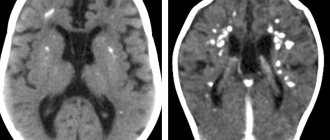Find out more about other diseases starting with the letter “C”: Compression of the brain; Senile chorea; Sensitive ataxia; Serous meningitis; "Rigid person" syndrome; Alien hand syndrome; Restless legs syndrome; Bogorad syndrome; West syndrome; Gaye-Wernicke syndrome; Guillain-Barre syndrome; Piriformis syndrome; Carpal tunnel syndrome; Carotid sinus syndrome; Kleine-Levin syndrome; Klippel-Feil syndrome; Cauda equina syndrome; Crumpy syndrome; Lambert-Eaton syndrome; Landau-Kleffner syndrome.
Cauda equina syndrome is a system of neurological symptoms in which the bundle of nerve fibers in the region of the spinal cord formed by the lumbosacral nerves of the conus medullaris is damaged. Clinically manifested by decreased tone of the legs, sensory disturbances in the area of innervation of damaged nerves, and dysfunction of the pelvic organs.
The diagnosis is established after consultation with a neurologist, based on the results of MRI, CT, and spinal puncture. Treatment can be conservative or surgical with further rehabilitation.
general information
The spinal cord ends at the level of the first lumbar vertebra. The nerves of the lumbar, sacral and coccygeal segments and the filum terminale form a bundle called the cauda equina. Vertebroneurologists distinguish damage to the cauda equina as a separate disease, regardless of the reasons that influenced it.
The syndrome appears in middle-aged people more often than in other patients. Children get cauda equina syndrome after injuries or pathologies of the lower parts of the spinal canal. In men, the disease is more common in women; it is associated with lifting heavy weights.
Causes of cauda equina syndrome
The main factor in damage to the terminal nerve bundle is its compression in the spinal canal. Among the most common causes, intervertebral hernia in the lumbar spine plays a key role. Sometimes inflammatory, external causes are found. The main underlying factors of the syndrome:
- Intervertebral hernia explains 15% of cases of the disease. Osteochondrosis of the spine and degenerative processes of intervertebral discs give rise to the formation of protrusion and accelerate its development. Lumbar hernias compress the cauda equina.
- Injuries. Fracture of the sacral vertebrae and spinal cord injury of the corresponding part cause defects in the nerve fibers. Compression can be generated by hemorrhages and hematomas. Cauda equina syndrome can become a complication of epidural anesthesia and surgery.
- Neoplasms. Tumors of a malignant nature grow into nerve bundles, damaging nerve tissue. Benign neoplasms arise from nerve sheaths (neurinoma), spinal ependymoma (ependymoma), fat cells (lipoma), meninges (meningioma) - all of them cause compression of the nerve roots.
- Curvature of the spine. Inherited pathologies of the spine in the lumbosacral region can significantly narrow the terminal part of the spine, creating conditions for compression damage to nerve fibers. Acquired deformities lead to age-related destruction (spondyloarthrosis deformans), dislocation of the lumbar vertebrae (spondylosis).
Cauda equina syndrome or When lower back pain is not just pain
5/5 3 votes.
Article written according to scientific standards and reviewed by a medical professional
This text is consistent with medical literature, medical guidelines, and current research and has been reviewed by medical professionals. Sources and author.
Lower back pain is a fairly common problem that many people face. Most often, it resolves without surgery and does not require special complex treatment. But there are diseases that cannot be ignored, and they also signal themselves with pain in the back, namely in the lumbar region. One of them is cauda equina syndrome (CES). If the problem is not diagnosed in time and treatment is not started, seemingly ordinary pain can develop into serious problems, including incontinence and even paralysis.
What is a ponytail?
Cauda equina syndrome (CES) is a condition characterized by compression of the nerve roots at the end of the spinal cord. It is this collection of nerves that is called the cauda equina because of its similarity to the tail of a horse. With this syndrome, the motor and sensory functions of the lower extremities and bladder are impaired. As a result - incontinence, impaired motor function, paralysis.
It is worth noting that the occurrence of the disease does not depend on gender or race. Moreover, the problem can affect a person at any age. The risk of the syndrome is higher if there has been a back injury or specifically a lumbar injury. CES can also occur in patients who have undergone surgery to remove a lumbar disc herniation.
Causes
The most common cause of CES is a massive herniated disc in the lumbar region.
Other possible causes of CES:
- Spinal injuries;
- Tumors;
- Spinal infections or inflammation;
- Lumbar spinal stenosis;
- Injuries to the lower back (falls, consequences of a car accident);
- Congenital anomalies;
- Spinal arteriovenous malformations (AVM);
- Spinal hemorrhages (subarachnoid, subdural, epidural);
- Complications after surgery on the lumbar spine;
- Spinal anesthesia.
Symptoms and diagnosis
Symptoms of CES can be very similar to those of other illnesses. Diagnosis is also complicated by the fact that symptoms develop and appear very slowly and can vary in intensity.
But with this syndrome, it is very important to seek help in time, and therefore you should be aware of the symptoms of the so-called “red flag”, that is, the first signals of the body that require consultation with a doctor. These include:
- Severe lower back pain;
- Motor weakness, loss of sensation, or pain in one or more often both legs;
- The so-called saddle anesthesia (inability to feel anything in those parts of the body that “sit in the saddle”);
- The first symptoms of bladder dysfunction (urinary retention or incontinence);
- Bowel incontinence;
- Sensory abnormalities in the bladder or rectum;
- Onset of sexual dysfunction;
- Loss of reflexes in the limbs.
The disease can also be suspected if, in the presence of several symptoms, the medical history includes back injuries, surgery on the lumbar spine, a severe infection, or if the medical history includes oncology.
CES diagnostics include:
- Magnetic resonance imaging (MRI): a test that produces three-dimensional images of body structures using magnetic fields and computer technology.
- Myelogram: X-ray of the spinal canal, which shows displacement of the spinal cord due to herniated discs, tumors, etc.
Treatment
Once CES is diagnosed and the etiology is established, surgery is usually recommended. It is very important not to hesitate and at the first symptoms to consult a neurosurgeon. Operative surgery is the best solution for patients with CES. Treatment within 48 hours of the onset of the syndrome is believed to provide significant benefit in improving sensory and motor deficits, as well as urinary and rectal function.
But even if you seek help later, the treatment will also be positive. And even if it is not possible to achieve 100% results at first, the restoration of function will continue in the subsequent years after the operation.
In addition, drug therapy in combination with periodic self-catheterization can help restore bladder and bowel function after surgery.
Undesirable consequences of CES
People diagnosed with cauda equina syndrome may experience not only physical pain, but also psychological problems. They find it difficult to work due to socially unacceptable problems with urinary incontinence, motor weakness and sensory loss. They may experience pain that will interfere with their ability to live their normal lives. Therefore, such patients need the support of family and friends, as well as competent treatment and a trusting relationship with the attending physician.
If the problem is ignored, it is fraught with undesirable consequences:
- Frequent urinary infections may develop.
- Sexual dysfunction will negatively impact your relationship with your partner.
- Severe pain may require special treatment with strong painkillers, and these, in turn, can have complex side effects and, as a result, provoke further health problems.
- Chronic pain can become “centralized” and spread to other parts of the body.
- Neurogenic pain, which is usually worse at night, can interfere with sleep. Constant insomnia will negatively affect your health, both physical and emotional. Additionally, this type of pain can cause a burning sensation that becomes constant and unbearable.
- Loss of sensation can range from complete numbness to the bladder, bowel, and genital areas.
- Weakness in the legs can lead to problems walking.
Cauda equina syndrome is one of those diseases that once again proves that pain cannot be ignored. It is good if such signals from the body turn out to be temporary and do not require medical intervention. But what if pain is a symptom? It is better to stop a possible problem in time than to deal with its consequences and complications later.
All information presented in the blog is for informational purposes only and does not replace an in-person consultation with a doctor!
Make an appointment with a specialist
Still have questions? Ask!
Sources:
- https://www.aans.org/Patients/Neurosurgical-Conditions-and-Treatments/Cauda-Equina-Syndrome
- https://www.spine-health.com/conditions/lower-back-pain/cauda-equina-syndrome
- https://www.webmd.com/back-pain/guide/cauda-equina-syndrome-overview#1
+0-0 0 vote.
Pathogenesis of the disease
The lumbar and sacral nerves, which are part of the structure of the cauda equina, provide innervation to the lower extremities, bladder, external genitalia, urethra, and rectal sphincter.
At the onset of the disease, a violation of their functionality determines irritation and increased excitation of nerve endings, with the presence of severe pain. The more the destruction or compression of nerve endings progresses, the more innervating functions are inhibited, sensitivity decreases, and muscle paresis occurs. Neoplasia, which is malignant in nature, destroys the membranes of the spinal canal and provokes metastases.
Clinical picture
Pain appears at the very beginning of the disease. It is concentrated in the lumbar and sacral region, and is remotely felt in the leg on the side of the injury, the groin area. The patient experiences hypersensitivity and poor tactile sensations in terms of painful sensations. When coughing and sneezing, the pain increases significantly, and decreases in a semi-sitting position. A decrease in sensitivity, felt as numbness, indicates increasing hypoesthesia.
Complaints of rapid fatigue while walking and lethargy of the muscles of the lower extremities are signs of motor dysfunction. The more active the pathological process becomes, the more severe the symptoms, and the damage is distributed to the other side of the body. Over time, independent walking becomes difficult.
Disruption of the innervation of the external genitalia leads to a significant decrease in their sensitivity. This, in turn, causes anorgasmia in women and erectile disorders in men. The pelvic organs react with urinary retention and persistent constipation to sensory impairment. Patients are not aware of fullness of the bladder and rectum.
Effective treatments
After determining the cause of cauda equina syndrome, the doctor individually develops treatment tactics. In any case, urgent decompression of the nerve endings is performed to prevent paralysis and disruption of the bladder and rectum.
Cauda equina syndrome responds to conservative treatment if compression is caused by infectious or inflammatory diseases. In such cases, treatment is carried out with painkillers, antibiotics, corticosteroids, and antiviral drugs.
Oncological pathologies that cause compression of nerve endings are eliminated by surgery, radiation treatment, and chemotherapy.
Surgical treatment allows you to decompress the nerve endings and eliminate the cause of the damage. This is the most effective and reliable way to eliminate compression of the nerve bundle. If a herniated disc is detected that causes cauda equina syndrome, the surgeon removes part of the vertebra or intervertebral disc.
In some cases, after surgery, Israeli doctors carry out conservative treatment to relieve pain and speed up recovery processes. The final stage of the treatment program at the First Medical Center of Tel Aviv is physiotherapeutic procedures and rehabilitation. The duration of the course depends on the degree of damage to the nerve endings.
Complications of the disease
If treatment is not complete or insufficiently adequate, the patient may suffer disability associated with walking pathology. A disorder in the perception of fullness of the bladder and rectum can provoke the formation of a diverticulum, infected urethritis, cystitis, pyelonephritis along the ascending route of infection. Untimely removal of metabolic products can cause the accumulation of toxins in the intestines and general poisoning of the body. Fecal blockage and acute urinary retention are conditions that require urgent medical attention.
Diagnosis of cauda equina syndrome
The initial signs of cauda equina syndrome can be mistaken for clinical symptoms of femoral nerve neuropathy, radiculitis, and lumboischialgia. It should be remembered that the manifestations of cauda equina syndrome have bilateral manifestations. It is necessary to question the patient in detail about the presence of disorders of the pelvic and genital organs.
To confirm the diagnosis, be sure to perform:
- Neurological examination. During a consultation with a neurologist, mono or paraparesis, decreased muscle tone, and degenerative disorders are discovered. Physiological reflexes (Achilles, anal, in men - bulbocavernosus) are not expressed. Sensitive disorders that occur in areas of innervation of nerve endings indicate injury to several lumbosacral nerves.
- CT scan. Spinal stenosis and pathologies of bone structures are clearly visible on CT images.
- Magnetic resonance imaging. Insufficient detection of soft tissue pathologies on CT requires MRI. The resulting images determine the presence of hematomas and neoplasia. The level of narrowing of the spinal canal is determined more accurately.
- Spinal tap. If during the procedure it is not possible to obtain cerebrospinal fluid (dry puncture), it is clear that the cerebrospinal fluid pathways are blocked by a tumor or hernia. There may be blood in the cerebrospinal fluid, which indicates hemorrhage. An increase in the amount of protein indicates neoplasia, signs of inflammation - arachnoiditis, myelitis.
- Histological analysis. It is performed in the presence of tumors to determine their structure, malignant or benign nature. The examination is carried out after the operation by examining the removed tissue.
Differential diagnosis is carried out to exclude polyneuropathies, mononeuropathies of the lower extremities, and lumbosacral plexitis. To eliminate other pathologies, the results of magnetic resonance imaging and computed tomography are important.
Diagnostics
A preliminary diagnosis of cauda equina syndrome is made based on the results of a patient examination, medical history, the presence of motor disorders in the lower extremities, impaired sensitivity in the perineal area, decreased reflexes in the lower extremities
Imaging tests include plain x-rays to help identify degenerative changes or injury. MRI (including with contrast) makes it possible to diagnose a tumor, infection, the presence of disc herniations and visualize nerve roots (their degree of compression). Based on the studies, the surgeon can plan the necessary treatment.
But not all people with low back pain and/or leg pain and changes in bowel or bladder function have cauda equina syndrome. Often, bladder problems are associated with a bladder infection (can be diagnosed with a urine test) or diabetes (can be diagnosed with a blood sugar test).
In addition, it is necessary to exclude the possibility of infection or oncological origin of symptoms. Therefore, it is necessary to conduct extensive laboratory tests such as general blood tests, blood biochemistry, serological tests (to rule out syphilis or Lyme disease).
Here is what allows you to reliably diagnose cauda equina syndrome:
- Disease history
- Physical examination: assesses muscle strength, reflexes, sensation, stability and motor abilities.
- Lab tests
- Magnetic resonance imaging (MRI) provides three-dimensional images of the spine.
- Myelogram - an x-ray method of imaging the spine with the introduction of contrast, allowing to determine the pressure on the spinal cord or nerves
- Computed tomography (CT).
Treatment of cauda equina syndrome
Therapeutic measures aim to eliminate the main root cause, compression of nerve endings. Medications are most often unable to cope with all symptoms, so surgical treatment is required. Complex therapy of cauda equina syndrome is determined by the following methods:
- Conservative treatment. The doctor prescribes analgesics, glucocorticosteroid drugs, and muscle relaxants. In case of intense pain, therapeutic blockades are provided - injections of an anesthetic solution together with corticosteroids into the area of the nerve plexuses. Acute urinary retention requires urgent catheterization of the bladder, prolonged constipation requires a cleansing enema.
- Surgery. Depending on the MRI results, tumor removal, hematoma, and discectomy are performed for herniated intervertebral spaces. Surgical correction is necessary for native pathologies. It is possible to perform spinal stabilization. After neoplasia is diagnosed, laminectomy is performed - expansion of the spinal space. Disorders of the pelvic organs and intensive progression of lower paraparesis are indications for urgent surgical operations.
- Rehabilitation. Measures to restore lost neurological qualities consist of massages, physiotherapy, and exercise therapy complexes. If tumors are detected, all of the above measures, except physical therapy, are contraindicated.
Symptoms
There are many symptoms of cauda equina syndrome in humans, and it is almost impossible not to notice them.
Pain
The main symptom of cauda equina syndrome is pain. Its intensity directly depends on how severely the nerve endings are compressed or damaged. The pain may appear gradually and progress slowly. At first, a person may only experience short-term attacks, such as at the end of the work day. Over time, attacks of pain may intensify, and the intervals between them may decrease. The pain can be acute, occur suddenly, and shoot through the lower back. In this case, the person’s general condition worsens, performance decreases, and even after a long rest, relief does not occur.
Muscle weakness
Another symptom of a pinched cauda equina can be muscle weakness. As a result of compression of the nerve bundles, the muscles stop receiving the amount of nerve impulses they need. Accordingly, their tone is disturbed, movements of the lower extremities are difficult, although the person may not feel pain as such. It becomes difficult for a person to walk, stand for a long time, and we are not talking about running, jumping and other physical activities at all.
Numbness in the groin area, tailbone area
Loss of sensation, or numbness, is another symptom that may indicate cauda equina syndrome. Numbness is localized in the groin area, in the buttocks, thighs, and also in the tailbone area.
Problems with the bladder and bowels
Compression of the nerve endings of the cauda equina can negatively affect the intestines and urinary system. A person may be worried about: excessive gas formation in the intestines, constipation, urinary incontinence, or, conversely, urinary retention. If you experience one or more of the listed symptoms, you should immediately consult a doctor. In the early stages of the disease, the situation can still be corrected. In cases where the nerve bundles of the cauda equina are severely suppressed, it is almost impossible to restore their function.
Prognosis and prevention
The prognosis of the disease directly depends on the root cause and the level of spread of damage. Complex treatment allows you to reverse the neurological deficiency. Lack of treatment causes irreversible destructive changes. Preventive measures are aimed at preventing spinal injuries and accurately performing spinal surgeries.
A single registration center for MRI/CT provides a convenient service for choosing a clinic for diagnostics of the body. On the mrt-v-msk website you can find out the prices for the examination and sign up for a diagnostic service online at a convenient time. Telephone operators will answer all your questions and provide up to 1,000 rubles for diagnostics.









